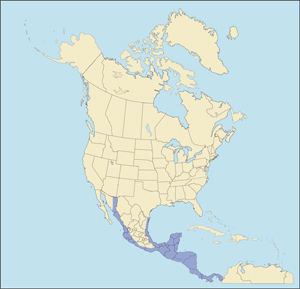 |
Panthera onca
Jaguar, Tigre (Sp), Jaguar (G), Jaguar (F). Called tigre locally in Mexico. Jaguar or jaguara is said to be a native name for this animal in South America.
DESCRIPTION (male) Adult North American jaguars are 6-8 feet (1.8-2.4 m) in length, including 18-24 inches (46-61 cm) of tail. Shoulder height 25-30 inches (64-76 cm). Weight 100-160 pounds (45-75 kg), sometimes more. Females are about 25 percent smaller than males. Chromosome count is 38.
The jaguar is the largest cat in the Western Hemisphere. About the same length and height as the cougar, but more compactly and powerfully built. The coat is yellow to reddish-yellow, with whitish or light buff underparts. There are black spots on head, neck and legs, and large black blotches on the underparts. The back and sides have large black rosettes with one or more black spots in the center. The tail is relatively short, with strong black markings toward the tip. Black, or melanistic, individuals are fairly common, but their spots can still be seen faintly.
BEHAVIOR The male is solitary and territorial, a wanderer with a home range that is twice the size of a female's and will overlap those of several females. Breeding usually takes place in the spring in northern areas, but there is no fixed season in the tropics. Females mate every 2-3 years, bearing a litter of 1-4 kittens that remain with the mother for about two years. Full growth and sexual maturity are reached in 3-4 years. Life expectancy about 15 years, although captives have lived as long as 22 years.
Jaguars are entirely carnivorous, preying largely on peccaries and deer, but also on smaller mammals, fish and snakes. They often kill domestic livestock, which has made them unpopular with ranchers and has led to their persecution. They are good tree climbers and excellent swimmers; unlike most cats, they are fond of water. May be diurnal or nocturnal, depending on the presence of humans. Eyesight and hearing are excellent, sense of smell reasonably good. As a so-called "great" cat, the jaguar is able to roar; however, its usual vocalization is a series of deep, raspy, coughing grunts.
HABITAT Forest, preferably dense and near rivers or swamps. Also in open country if prey animals are plentiful there. Found in scrub and desert in northern parts of its range.
DISTRIBUTION Mexico and Central America. Wanderers occasionally occur as far north as Arizona, New Mexico and Texas.
Also found throughout South America, except in the extreme south (South American jaguars are larger than those in North America).
TAXONOMIC NOTES Eight subspecies of jaguar are usually recognized, five from North America and three from South America. The North American subspecies are: arizonensis (Arizona jaguar) from Sonora, Arizona and New Mexico, pale buff in color with rosettes broken into spots; hernandisii (Pacific Coast jaguar) from a narrow strip along the Pacific coast from Sonora to Oaxaca, with broken-up, barely perceptible rosettes; veraecrucis (Gulf Coast jaguar) from the coastal forests along the Gulf of Mexico from Texas to Veracruz; goldmani (Yucatan jaguar) from the Yucatan Peninsula, with a bold, intense color pattern; and centralis (Central American jaguar) from Guatemala to Panama and extending into Colombia in South America, a small form with distinct rosettes. All North American subspecies are combined for record-keeping.
STATUS In parts of Mexico and Central America (and also in South America), jaguars are plentiful and detrimental to livestock, and may lawfully be hunted. Nonetheless, all jaguars everywhere are listed as endangered by the USF&WS (1972) and are on Appendix I of CITES (1975). They may not be imported into the United States, which is unfortunate for U.S. residents, as the jaguar has always been considered one of the top hunting trophies of the Americas and of the world.
REMARKS The University of Mexico has been authorized by the Mexican government to conduct a jaguar study program whereby a limited number of jaguars are darted and tranquilized, photographed, measured, aged, fitted with radio collars and revived so that their movements and numbers can be monitored and evaluated. The jaguar is baited and/or trailed by a pack of dogs until it climbs a tree where it can be darted. A wildlife biologist provided by the university or an official of the biosphere reserve accompanies the darting expedition, and care is taken to assure that the jaguar is not harmed. For a fee (which is used to support the program), sportsmen are permitted to take part in these non-lethal hunts and to fire the dart gun. This program is coordinated in Mexico by United for Conservation, a Mexican non-profit organization directed by SCI member Carlos Manterola. In the early stages of this program it was coordinated by the late David Hanlin.
SCI accepts Record Book entries for jaguars (and incidental cougars) darted as part of this study, and uses body measurements taken by the field biologist to arrive at the score.
|




